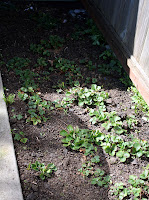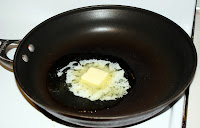Pancakes are one of those things that
are ridiculously easy to make, but seem like they'd be a pain without
one of those just-add-water mixes. Even though making them from
scratch only involves a few ingredients, the thought of all that
measuring first thing in the morning tires me out. What can I say?
I'm just not a morning person.
 |
| Basic ingredients |
Luckily, I found a recipe for a good pancake mix (along with several others). One batch of the mix makes enough for around five
batches of pancakes. I can make the mix whenever I want and then
just add the wet ingredients and have pancakes in the morning. That's an
acceptable level of effort for me.
 |
| What? It fits.. |
I usually make a double batch of the
mix; that's as much as the biggest bowl I own will hold. Actually,
it's a little more than the bowl will hold, so I make a bit of a mess
as I mix it all up. However, the end result is
enough mix for 10-11
batches of pancakes, so I don't have to make it all that often.
After I had made it a couple times –
and had to look up the recipe each time – I got smart, and just
wrote it down and taped it to the container. This also helps prevent
me from thinking it's just regular flour and trying to make bread out
of it...which has almost happened a couple of times.
 |
| This level of mess is not unusual for me |
 |
| Children walking nearby may get messy as well |
These pancakes are one of Zoey's
favorite meals, so it made sense to make them for her birthday. I
thought I'd get fancy and make them in shapes, using cookie cutters.
That was a Bad Plan. It probably would have worked okay if I had
chosen simpler shapes and thought to spray the cutters. However, it
was morning so I did neither. A couple problems arose. First,
because the batter couldn't spread out, it went up, making the
world's thickest pancakes. I could adjust for that, however, and the
pancakes cooked fine. Unfortunately, I had to mangle them to get
them out of the cutters.
 |
| It started well... |
 |
| What? It's OBVIOUSLY a stegosaurus... |
Lesson learned; pancakes should be
round unless made by someone with the talent to free-hand shapes. In
case there was any doubt, I am not
that person. It doesn't really matter, since both of my kids get
their pancakes cut up before eating them anyway, but I feel like they
should at least know the pancakes were cool at one point.
To
compensate for the lack of neat pancakes, I made some strawberry
syrup to go on top of the boring rounds.
The
syrup was really easy to make – equal parts sugar and water, and
about twice that in strawberries. I think. I didn't really measure
the berries, just threw them in. They were frozen and stuck
together, so measuring would have been a pain in the rear, and it was
still morning.
 |
| Sugar. With water. MIB style |
Since
I used frozen berries, I didn't worry about chopping them up since I
knew they'd get mushy when they thawed anyway (yay for less effort!).
If it was later in the year, and local berries were ripe (curse you,
people that live in areas that already have ripe strawberries...I'm
looking at you,
Californians!) I would probably cut them in half and/or mash them up
a bit before adding them to the sugar and water.
 |
| And some berries |
As is,
however, I just dissolved the sugar in the water, added the
berries, and stirred every once in a while as I made the pancakes. The
berries were so soft, that I just had to mush them a little with the
spoon to get them to fall apart fully. By the time the pancakes were
done, so was the syrup. The recipe made a lot, so I have a pint jar
of deliciousness left in the fridge; we didn't exactly go light on
it, either! I'm sure Zoey will take care of that in short order.
Unless Randy beats her to it, that is.
 |
| Who needs pancakes? Just eat the syrup! |
RECIPES:
PANCAKE MIX:
6 c all-purpose
flour
2 c whole wheat
flour
2 c powdered milk
½ c sugar
3 T baking powder
1 ½ T salt
Mix all ingredients
together. And store.
PANCAKE RECIPE:
Makes approximately eight 6-inch
pancakes.
2 c pancake mix
1 ½ c water
2 T oil
1 egg
Pour pancakes onto
a hot skillet. Cook until bubbles form and pop. Flip. Cook until
pancakes puff slightly and steam.
STRAWBERRY SYRUP
RECIPE
1 c water
1 c sugar
2 c strawberries
(10-15 large berries)
Create a simple
syrup by combining the water and sugar in a medium saucepan. Heat
over medium-high heat (between 6 and 7 on my dial) until all the
sugar is dissolved and the liquid is clear.
If working with
fresh berries, quarter the berries and mash them slightly with a fork
or the back of a spoon. Frozen berries can be added whole.
Add the berries to
the simple syrup and heat to a boil, stirring occasionally, and
breaking up large clumps with the spoon.
Boil for 3-5
minutes, stirring frequently to prevent scorching. Remove pan from
heat, and allow to cool and thicken for 5-10 minutes.


























